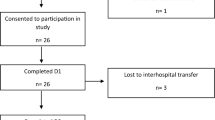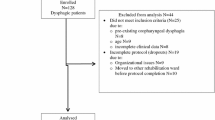Abstract
Dysphagia is common after stroke and is associated with increased morbidity and mortality. Predicting those who are likely to have significant prolonged dysphagia is not possible at present. This study was undertaken to validate the Royal Adelaide Prognostic Index for Dysphagic Stroke (RAPIDS) in the prediction of prolonged dysphagia following acute stroke using clinical and radiographic features. A prospective study of unselected, consecutive admissions to the Royal Adelaide Hospital acute stroke unit was undertaken. Clinical and radiographic features applicable to the RAPIDS test were calculated and the sensitivity, specificity, and likelihood ratio for predicting prolonged dysphagia were calculated with 95% confidence intervals (CI). Of 104 subjects admitted with acute stroke, 55 (53%) had dysphagia and 20 (19%) had dysphagia requiring nonoral feeding/hydration for 14 days or more or died while dysphagic prior to 14 days. The RAPIDS test had sensitivity of 90% (95% CI = 70–97%) and specificity of 92% (95% CI - 84–96%) for predicting this latter group of patients. We conclude that the RAPIDS test can be used early to identify patients likely to have prolonged dysphagia. This test could form a basis for selection of patients for trials of nonoral feeding methods.

Similar content being viewed by others
References
Gordon C, Langton Hewer R, Wade DT: Dysphagia in acute stroke. BMJ 295:411–414, 1987
Mann G, Hankey G, Cameron D: Swallowing function after stroke. Prognosis and prognostic factors at 6 months. Stroke 30:744–748, 1999
Paciaroni M, Mazzotta G, Corea F, Caso V, Venti M, Milia P, et al.: Dysphagia following stroke. Eur Neurol 51:162–167, 2004
Kidd D, Lawson J, Nesbitt R, MacMahon J: The natural history and clinical consequences of aspiration in acute stroke. QJM 88:409–413, 1995
Broadley S, Croser D, Cottrell J, Creevy M, Teo E, Yiu D, et al.: Predictors of prolonged dysphagia following acute stroke. J Clin Neurosci 10:300–305, 2003
Gariballa SE, Parker SG, Taub N, Castelden CM: Influence of nutritional status on clinical outcome after acute stroke. Am J Clin Nutr 68:275–281, 1998
Bath P, Bath F, Smithard D: Interventions for dysphagia in acute stroke. Cochrane Database Syst Rev:CD000323, 2000
Park RH, Allison MC, Lang J, Spence E, Morris AJ, Danesh BJ, et al.: Randomised comparison of percutaneous endoscopic gastrostomy and nasogastric tube feeding in patients with persisting neurological dysphagia. BMJ 304:1406–1409, 1992
Norton B, Homer-Ward M, Donelly MT, Long RG, Holmes GKT: A randomized prospective comparison of percutaneous endoscopic gastrostomy and nasogastric tube feeding after acute dysphagic stroke. BMJ 312:13–16, 1996
DePippo KL, Holas MA, Reding MJ: Validation of the 3-oz water swallow test for aspiration following stroke. Arch Neurol 49:1259–1261, 1992
Smith H, Lee S, O’Neill P, Connolly M: The combination of bedside swallowing assessment and oxygen saturation monitoring of swallowing in acute stroke: a safe and humane screening tool. Age Ageing 29:495–499, 2000
Lim S, Lieu P, Phua S, Seshadri R, Veketasubramanian N, Lee S, et al.: Accuracy of bedside clinical methods compareed with fiberoptic endoscopic examination of swallowing (FEES) in determining the risk of aspiration in acute stroke patients. Dysphagia 16:1–6, 2001
Martino R, Pron G, Diamant N: Screening for oropharyngeal dysphagia in stroke: insufficient evidence for guidelines. Dysphagia 15:19–30, 2000
Shah S, Vanclay F, Cooper B: Improving the sensitivity of the Barthel Index for stroke rehabilitation. J Clin Epidemiol 42:703–709, 1989
Warms T, Champion R, Mortensen L: The Parramatta Hospitals’ Assessment of Dysphagia, 3rd ed. Sydney: Westmead Hospital and Community Health Services, 1998
Logemann J: Evaluation and treatment of swallowing disorders. San Diego, CA: College Hill Press, 1983
Straus SE, Wong P, Tomlinson G: Centre for Evidence-Based Medicine. http://www.cebm.utoronto.ca/practise/ca/statscal/ 2004 (Accessed September 1, 2004)
Barer DH: The natural history and functional consequences of dysphagia after hemispheric stroke. J Neurol Neurosurg Psychiaty 52:236–241, 1989
Horner J, Massey E, Riski J, Lathrop D, Case K: Aspiration following stroke: clinical correlates and outcome. Neurology 38:1359–1362, 1988
Modrego PJ, Mainar R, Turull L: Recurrence and survival after first-ever stroke in the area of Bajo Aragon, Spain. A prospective cohort study. J Neurol Sci 224:49–55, 2004
Hamdy S, Aziz Q, Rothwell JC, Singh KD, Barlow J, Hughes DG, et al.: The cortical topography of human swallowing musculature in health and disease. Nat Med 2:1217–1224, 1996
Daniels SK, Foundas AL: The role of the insular cortex in dysphagia. Dysphagia 12:146–156, 1997
Zald DH, Pardo JV: The functional neuroanatomy of voluntary swallowing. Ann Neurol 46:281–286, 1999
Mann G, Hankey GJ: Initial clinical and demographic predictors of swallowing impairment following acute stroke. Dysphagia 16:208–215, 2001
Author information
Authors and Affiliations
Corresponding author
Rights and permissions
About this article
Cite this article
Broadley, S., Cheek, A., Salonikis, S. et al. Predicting Prolonged Dysphagia in Acute Stroke: The Royal Adelaide Prognostic Index for Dysphagic Stroke (RAPIDS). Dysphagia 20, 303–310 (2005). https://doi.org/10.1007/s00455-005-0032-y
Published:
Issue Date:
DOI: https://doi.org/10.1007/s00455-005-0032-y






